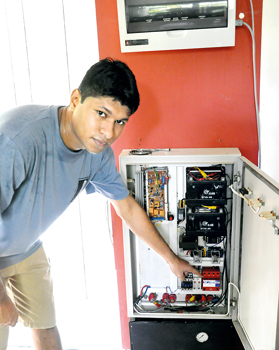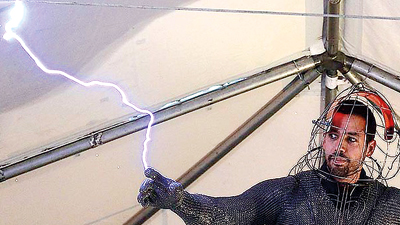When lightning strikes this surge diverter will do its bit
When you run an ice-cream factory, you simply can’t afford to let the ice-cream melt! Nor can you risk the refrigerators being damaged during a thunderstorm.
This was the dilemma Sanka Nanayakkara’s family who used to own an ice cream factory faced on a regular basis. The slightest hint of a thunderstorm even in the middle of the night would see Sanka’s father hurrying to the factory to switch off the power supply and then waiting till the storm eased to switch the power on again.

No more melted ice cream: Sanka points to his invention.
This constant running back and forth had to come to an end! Sanka and his dad, who coincidentally is a meteorologist, put their heads together to come up with a solution.
Sanka’s invention was the ingenious Nanavidu Lightning Surge Diverter which not only solved the problem, but also obtained a patent, and won him First Place at the Presidential Awards for Inventions in 2002 and the Silver Medal at the International Exhibition of Inventions of Geneva. He is now nominated for ‘The Ray’ award this year.
How exactly does the Nanavidu Lightning Surge Diverter work?
A lightning stroke is an electric discharge between a thunder cloud (Cumulonimbus) and the earth. Though the exact nature of charge built up in the clouds is unknown, scientists believe that the vertical movement of electrically charged particles, builds up the charge in the cloud. Up draughts and down draughts separate the charges in the cloud, with the top layer, mainly constituting ice crystals, frequently getting positively charged, while the lower water droplets obtain negative charges. These negative charges induce positive electricity on the ground.
When lightning strikes the ground it can either be a direct or indirect hit. Damage from direct hits can be warded off by having proper lightning conductors in place. However, the indirect hits, mostly due to induced charges in power lines and strikes far away from the actual site, could result in surges which though of short duration, are over several million volts and cause extensive damage. It is to minimise such damage that surge diverters are used, as the trip switch proves inadequate.
“A surge diverter is a kind of high surge voltage filter which finds an easy path to the ground for the high voltage surges, thus minimising damage to property,” explains Sanka.
However, these surge diverters often prove unreliable. As the strength of an impending lightning stroke cannot be predicted and as there is a limit to a surge diverter, any excessive surge will ruin not only electric devices but also the surge diverter itself!
Sanka’s Nanavidu Lightning Surge Diverter is a more effective means of protecting devices by disconnecting and isolating devices from power lines during a thunderstorm. It does not need manual disconnecting and connecting of the power supply.
“It can sense lightning, decide on the danger limit and disconnect equipments in the circuit and isolate them from power lines,” explains Sanka. It would also connect standby power to the equipment, moniter the end of the danger period and reconnect mains. All done automatically!
The Nanavidu Lightning Surge Diverter is able to handle power surges exceeding normal working voltage.
Two surge diverters and two isolators are built in to the Nanavidu Lightning Surge Diverter. The first surge diverter will ground any value below 100kA (kilo ampere). The chance of a thunderstorm exceeding 100kA is approximately one percent. However, in that unlikely event, the second surge diverter of 20kA and the two isolators would ensure the protection of electric appliances.
The Nanavidu Lightning Surge Diverter is quite costly to produce but this can be remedied if the rate of production increases. And increasing the production seems vital in today’s context, where global warming has resulted in the frequency and strength of lightning accelerating dramatically.
Follow @timesonlinelk
comments powered by Disqus
























